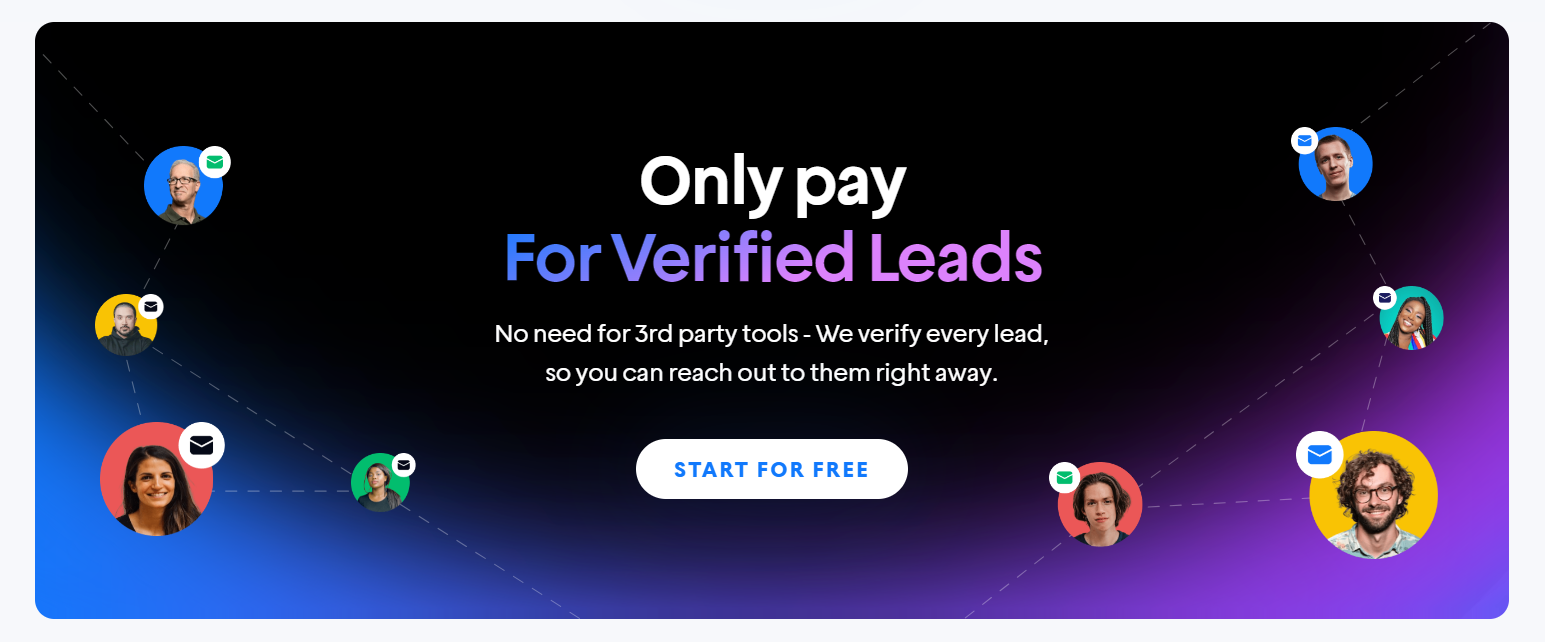Every business needs a sustainable, repeatable, and measurable lead generation process—this results in predictable revenue, better quality leads, and an efficient means to scale.
But you can’t just copy strategies. It must be tailored to your business. We can always take inspiration from how other businesses approach lead generation.
What’s important is how we iterate on those to make it our own.
By the end of this guide, you’ll be able to grasp the fundamentals of strategic lead generation, create your process, and apply it to your next sales strategy. But first, we need to learn:
- What is a lead generation process
- The different types of leads
- The different parts of a lead generation process
- Lead generation process examples
- How to create your own tailored lead generation process
What is a Lead Generation Process?
A lead generation process is a strategy for finding new customers. It should base itself on fundamental principles and have enough flexibility to adapt to changes.
You can use several strategies to capture lead information, such as lead capture pages, blogs, or social media. Some businesses focus on one channel; others may need to use more.
To identify which strategy suits your business best, learn about your market, know your business's strengths, and clearly define the type of lead you want to go for.
The Different Types of Leads

Creating an efficient, dynamic, and sustainable lead generation process requires understanding the type of leads we’re going for and where leads are along your sales pipelines. Here’s what we need to look into:
Warm Leads
Warm leads are potential customers who are already familiar with your brand, product, or services but haven’t contacted you directly. These are leads who have read your blogs, social media followers, or those who have watched a couple of videos from your brand.
Cold Leads
Cold leads are people who haven’t heard of your brand just yet, but you offer a solution to their pain points. Cold emails are used to reach out to these leads. To make this strategy more effective, we’d need personalized prospecting emails.
Hot Leads
Hot leads are potential customers with high buying intent. These leads have talked to your SDRs, already had a product demo, or asked for a custom quote. To ensure a deal, SDRs need to learn sales closing techniques.
The Parts of a Lead Generation Process
Think of lead generation as a system with its own moving parts that keep it running. Each part just as important as the next. Here are the fundamental parts of a lead generation process:
Set Your Goals and Plan For It
Goal setting is crucial for your overall lead generation campaign. It helps you set a benchmark for your team, identify key performance indicators, and set an optimal budget.
For example, you can set a goal for reaching “x revenue” this quarter. From there, you can work backward and calculate how many leads are required to hit that goal.
Don’t forget to delegate tasks to the right departments. For example, marketing should handle most inbound sales strategies like content campaigns or social media ads.
Meanwhile, your sales department can spearhead outreach like cold emails, drip email campaigns, or sales follow-ups.
Research the Industry, Your Competitors, and Your Audience
You need the right strategies to find qualified leads with high buying intent. To help you zero in on that strategy, you must learn the market—your competitors and your audience.
For example, if you’re into B2B SaaS, your target audiences are probably high-level executives, business owners, or CEOs. You can find these people manually on platforms like LinkedIn.
There are free lead-finder tools that help you streamline your search. Think about the people who benefit most from your offering, then build your ICPs and buyer personas around them.
Understand their pain points, sales cycles, or unconsidered needs. Doing so helps you create curated content that resonates with your target audiences.
Create Great Content Tailored For Your Target Audience
Valuable content is still king whether you’re doing inbound or outbound lead generation. The question now is, what type of content works for what medium?
For example, infographics might work for social media. Case studies might be better attached to an email for warm leads. Bite-sized information with a link to your guide works great on Twitter.
Remember, your goal with your content is conversions. But, the purpose of your content is always to provide immediate value or present solutions to problems.
The better the content, the more likely it’ll be shared or received positively. More importantly, it helps your brand stay top-of-mind when a lead decides to make a purchase.
Track Your Leads In the Pipeline
The best way to track your leads is with a sales tracking system or CRM. Instantly.ai has its own lead tracking system called DealFlow CRM.
With DealFlow, you can immediately track leads across all your email campaigns. You don’t need to switch between apps or pay extra for a separate tool.
Most CRMs will have automation capabilities. Users can automate email sequences, sales cadences, and the overall nurturing process.
What’s more important is tracking how a lead engages with your content as they move down your funnel. This will help you score and qualify leads.
Score and Qualify Leads
Scoring and qualifying help your SDRs focus on leads who are most likely to convert. There are several qualification methods to choose from, such as BANT or MEDDIC.
These qualification or scoring methods determine where a lead should be in your funnel. Most businesses score leads from 1-100.
Let’s say a lead goes to your website and signs up for a newsletter. That could be worth 30 points. The lead also spends time on your pricing page, that could be 5 points.
And then, the lead downloaded a case study in exchange for a business email—that could be another 30 points. This will help you categorize leads into:
- New leads: First contact from cold emails or just got an introduction to your company.
- Working leads: SDRs already conversed with these leads.
- Nurturing leads: These are leads with buying intent but not currently interested.
- Unqualified leads: They aren’t interested in your offer and don’t have buying power.
Send Qualified Leads to Your Sales Team
With the help of a lead qualification tool, scoring strategies, and CRM, you’ve probably been able to identify leads with high buying intent. All that’s left is to send them to your sales team.
Having a list of qualified leads streamlines the sales process. SDRs can strategize the best sales approach when they already know key information about the leads.
That’s because qualification allows you to gain insights into the needs of each lead, internal issues that need to be addressed, or potential objections to your offering.
After each interaction, record key metrics so you can evaluate your performance and strategize on improving your lead generation process.
Evaluate Performance to Improve Your Next Lead Generation Campaign
Did your campaign hit its target? Were you off on your benchmarks by a large margin? You can easily answer these questions with the help of data from your CRM or lead-tracking tools.
Ensure that you’re recording each interaction. Run an A/B test between strategies to see which works best for the lead segment.
As mentioned earlier, your KPIs should be based on your goals. Campaign data helps identify strategies you need to keep, those you can improve, and ones you need to scrap.
Examples of Great Lead Generation Processes
Now that we know the fundamental parts of a lead generation process let’s look at some great examples. Find what works for you and adjust it to fit your needs.
Streamlined Lead Generation With Instantly B2B Lead Finder

Lead finder tools like Instantly B2B Finder allow you to zero in on the leads that fit your ICP and buyer personas. You can find leads based on industry, keywords, or leads similar to your clients.
All the leads are pre-verified, and you’d only have to pay for verified leads. Once you’ve built your email list, you can run cold email campaigns immediately in one tool.
First, set your goals. Identify your ICPs and buyer personas. Use the B2B Lead Finder’s advanced filtering options, create your email list, and run your cold email campaigns.
Then, track your leads through Instantly’s Dealflow CRM. The lead generation process is as simple as that! You don’t need to switch between two or three tools.
Free Webinar Strategy
A great way to attract leads is by offering value or insights. Free webinars are a great way to do just that. From the perspective of your audience, it’s a win-win.
They have an issue, and your webinars offer solutions—and it’s for free. People who attend your webinars can easily be converted to qualified leads.
Plus, you get the added benefit of being an authority on a topic or niche. Here’s how you can make it work:
- First, find common issues in your industry. Focus on offering solutions to that.
- Educate your audience on how to replicate your solution to the common issue.
- Introduce yourselves as the ultimate solution. Cover the immediate benefits.
Social Media Marketing
Social media and content marketing go hand-in-hand. Great content equals a more engaged audience. You get to build brand awareness and drive traffic to your lead capture pages.
But remember, inbound campaigns like social media marketing, paid ads, or organic social media traffic should be redirected to lead capture pages on your website.
When launching a campaign, make sure it synergizes across all platforms. Stick to a unified message. If you’re using social media to create buzz for your webinars, focus on that.
You can collaborate with industry influencers, invite thought leaders, or build a community. It creates a positive feedback loop where you can use user-generated content to drive traffic.
Referral and Loyalty Programs
Leads from referrals are more likely to convert compared to leads from most acquisition strategies. One of the best ways to get referrals is by creating loyalty programs.
Make sure the loyalty programs are beneficial for both you and your customers. Think discounts, perks, or exclusives. Try to create a sense of community around it.
According to studies, 86% of B2B buyers think word-of-mouth is the main factor they consider when purchasing. And 83% of customers consider referring products and services they like.
That’s a lot of potential customers waiting to be converted into a sale. The process is simple. First, make the program easy and convenient to be a part of. Make the incentive worth the time. Then, track your results and adjust the strategy to make it more efficient.
Search Engine Optimization (SEO)
SEO should be a standard for all businesses. It helps you build authority and improve user experience. But remember, SEO isn’t a “magic bullet” that immediately gets you to the #1 spot.
It’s an ongoing process that ensures your site is fully optimized for web crawlers and your audience. Delivering valuable content will always be the goal. SEO is merely the vehicle.
You get optimized content, faster site speeds, carefully curated keywords, and improved site structure or navigation.
Key Takeaways
No matter what lead generation strategy you choose to use, the fundamental process remains the same. As a quick recap, here’s what you need to consider:
- Set your goals. This is what will ultimately define your key performance indicators.
- Research your industry, your audience, and your competition.
- Always track lead activity with a CRM or lead-tracking software.
- Create a qualification process. You can use scoring methods or frameworks like BANT.
- Send qualified leads to your SDRs. These are the leads who are most likely to convert.
- Evaluate your performance and iterate.
With your lead list qualified and ready, your SDRs will need the right outreach tool. That’s where Instantly comes in. Try it out for free today!





